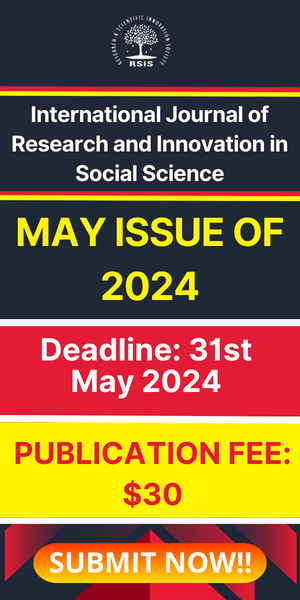Micromanaging Behaviour and Employee Productivity in SMEs in Rivers State
- May 23, 2022
- Posted by: RSIS
- Categories: Entrepreneurship, IJRISS, Management
International Journal of Research and Innovation in Social Science (IJRISS) | Volume VI, Issue IV, April 2022 | ISSN 2454–6186
Micromanaging Behaviour and Employee Productivity in SMEs in Rivers State
Amadi Martins Ndidi1, Amah, Edwinah (PhD)2, Okocha, Belemenanya Friday (PhD)3
1Doctoral Candidate, Ignatius Ajuru University of Education, Nigeria
2Professor of Entrepreneurship & Management, University of Port Harcourt, Nigeria
3Researcher, University of Port Harcourt, Nigeria
Abstract: Companies are always needing an individual to lead/manage its employees. However, some managers have been known to want to direct and control every move/task performed by their subordinates (known as micromanagement), which creates a sense of insecurity and disengagement among the employees. Employee morale and employee turnover were adopted as measures of productivity in this study. A critical review of extant literature revealed a nexus between micromanaging behaviour and employee productivity. Micromanagement, it was found, is not all negative; under certain instances and settings, it can be beneficial. It can be advantageous to a company if it is done correctly. Accordingly, managers must be aware of their employees’ performance and attitudes, but this must be done in a non-critical manner. Furthermore, it was recommended that entrepreneurs ought to: refrain from meddling in the middle of their employees’ work by assigning tasks based on their employees’ strong suits; trust their team; consider what knowledge and resources an employee would require to do delegated duties on their own, and instead of completing the job for them, focus on obtaining them that information. Instead than focusing on the process itself, think about the outcomes you want to see at the end of the project. describe the assignment’s end goal and then inquire as to how your employee would approach the problem; and enable their staff to make mistakes.
Keywords: Micromanaging Behaviour, Employee Morale, Employee Turnover, Employee Productivity
I. INTRODUCTION
An organization today operates in a highly competitive and dynamic environment. In such a situation, a company would look for an individual to lead/manage its employees. Some managers, however, like to direct and control every move/task performed by their subordinates. Employees will feel insecure and disengaged as a result of this. Micromanagement is a word that has been used to describe this type of leadership. It frequently entails little elements being planned and giving employees the impression that they are being watched (DeCaro et al., 2011). Micromanaging can be advantageous in organizations when managers’ intervention is required to boost productivity. This could be because the staff are unskilled or technically incapable of doing the task at hand. This management style is particularly useful in some short-term situations, such as onboarding new employees, increasing the efficiency of underperforming staff, managing high-risk regions, and when no one is available to take care of any job.


